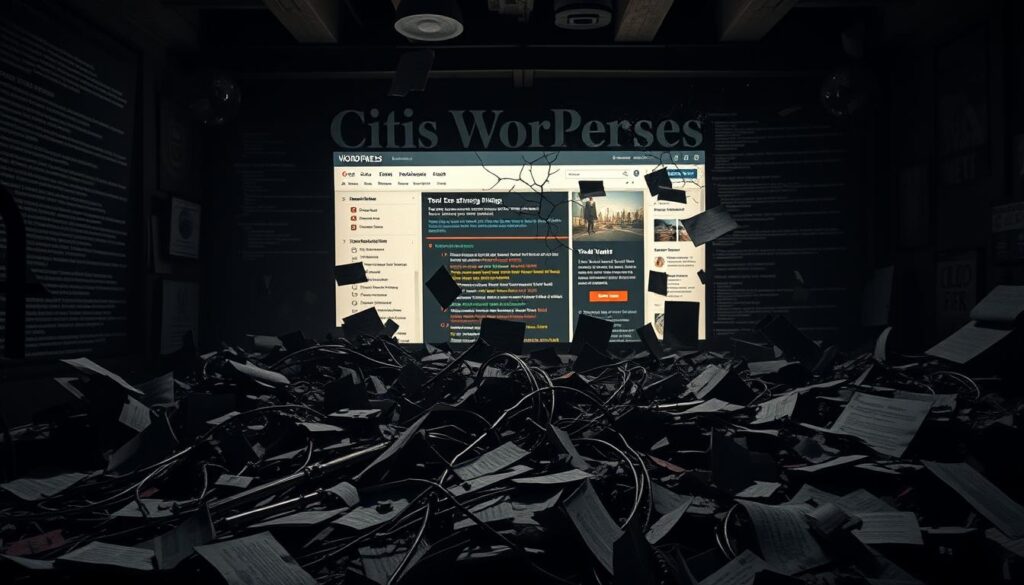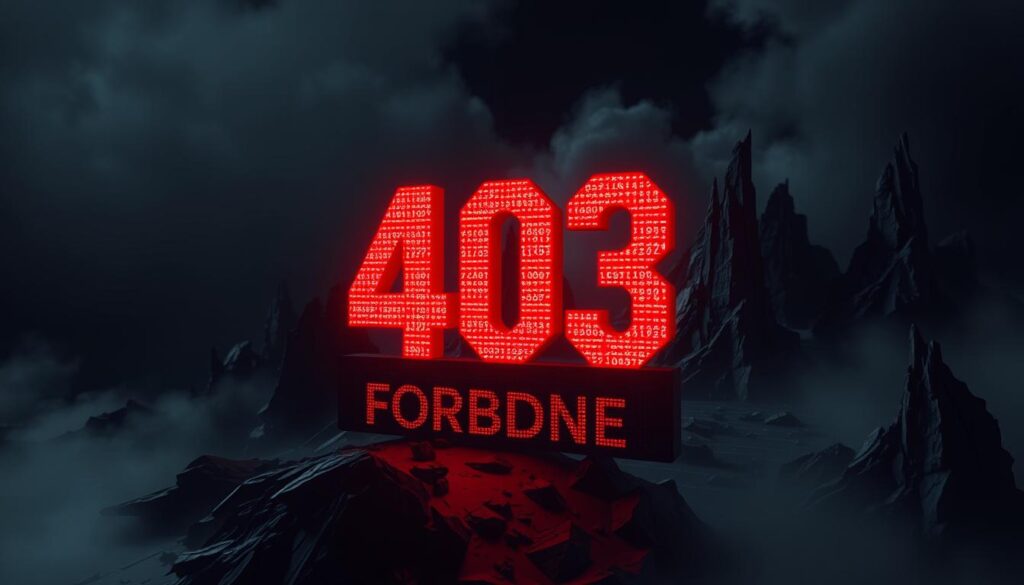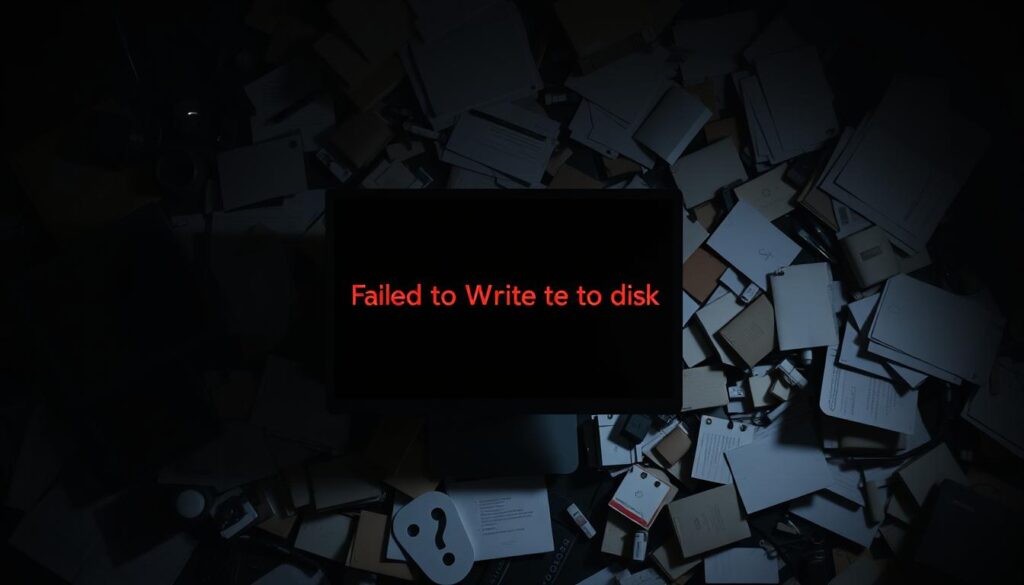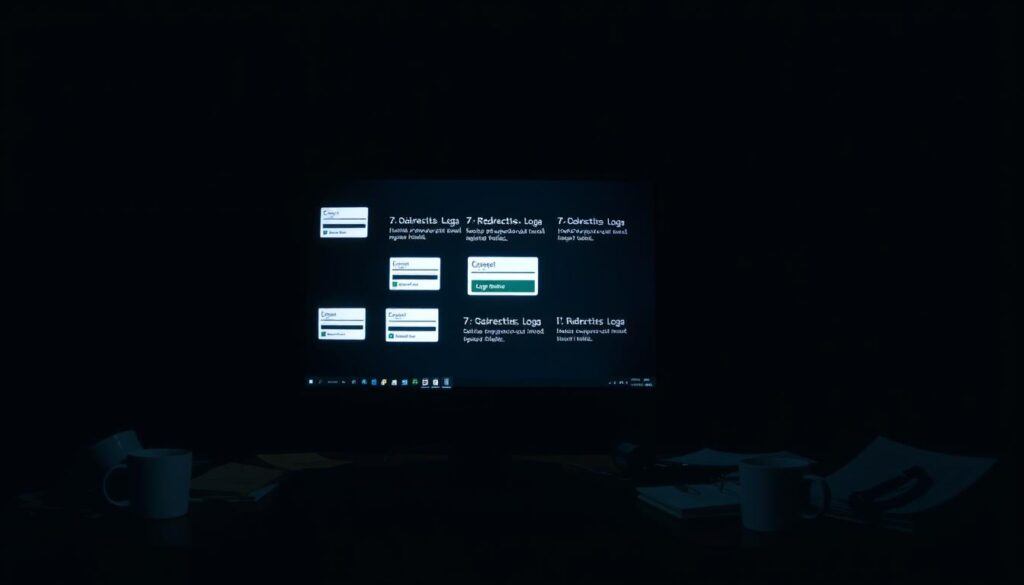
Surprising fact: a single minute of downtime can cost a mid-size U.S. company thousands in lost revenue and search visibility.
Recurring internal server and database connection failures still top support queues. These common faults — from the white screen to redirect loops — cut visitor trust and lower SEO value when they persist.
In this short guide, we map seven costly categories you must fix fast: outdated plugins and themes, database connection breakdowns, memory and resource mismanagement, permalink and .htaccess faults, 403 security misconfigurations, SSL/mixed content oversights, and media/email/permissions pitfalls.
Expect practical, step-by-step fixes drawn from proven support playbooks: check error logs, regenerate a fresh .htaccess, reset permalinks, verify database credentials, increase PHP memory, repair tables, and enforce HTTPS with SMTP for reliable mail delivery.
Key Takeaways
- Persistent errors cost visits and hurt SEO; fast triage wins back traffic.
- Adopt staging, backups, and rollbacks before updating extensions.
- Simple fixes like permissions (644/755) and increased PHP memory prevent many failures.
- Enforce HTTPS and switch to SMTP to protect trust and email delivery.
- Modern hosts should offer current PHP, clear SLAs, and timely support for server problems.
Why These WordPress Site Issues Matter for U.S. Businesses in 2026
Every minute a page returns an error costs real customers and long-term search visibility. Downtime during campaigns or checkout flows drives cart abandonment and reduces lifetime value. Repeated 500/503 responses and redirect loops also risk search engines de-prioritizing pages.
SEO and traffic suffer quickly. Crawl traps, index bloat from 404s, and slow server responses push rankings down and lower click-through rates. Mixed content and SSL warnings make visitors leave before forms or purchases complete.
What changed in hosting and security
Hosts now restrict PHP mail(); SMTP with authentication is required for reliable delivery. Default hardening, WAF/CDN integration, and correct file permissions (644/755) are expected to avoid 403 and upload failures.
Keeping modern PHP and database versions aligned prevents compatibility problems and improves performance. Quick mean time to recovery (MTTR), proactive monitoring, and the right hosting agreement are essential insurance when a database connection or other server problem appears.
- Connect outages to lost revenue: downtime = abandoned carts.
- Raise alarms early: monitoring lowers time to resolution and protects SEO.
Relying on Outdated Plugins and Themes (Catalyst for 500 Internal Server Error and White Screen)
Outdated extensions and themes often cause sudden critical failures such as a blank page or a universal 500 internal server response. These failures show up quickly after updates or when PHP versions change.
Warning signs
White screen of death, “There has been a critical error,” or a universal internal server error after an update are clear signals. If multiple pages go blank, start triage immediately.
Root causes
Common triggers include deprecated code paths, compatibility gaps with the current PHP version, and plugins that hook the same functions. A corrupt .htaccess can also produce blank pages and server failures.
Action plan
- Disable all plugins via dashboard or SFTP, then reactivate one at a time to isolate the faulty plugin.
- Switch temporarily to a default theme to rule out theme-level conflicts.
- Regenerate a fresh .htaccess by resetting permalinks or creating a new file.
- Use staging for updates and keep full backups and version pinning for quick rollback.
- Monitor error logs after changes to catch regressions early.
“A controlled update workflow and fast rollback plan cut downtime and protect search visibility.”
| Problem | Likely Cause | Quick Fix |
|---|---|---|
| Blank page / white screen | Memory exhaustion or plugin conflict | Increase PHP memory, disable plugins, test theme |
| 500 internal server | Buggy plugin or corrupt .htaccess | Deactivate plugins, regenerate .htaccess |
| Critical error notice | Fatal PHP error from incompatible code | Enable debug logs, isolate offending plugin or code |
Ignoring Database Health Leads to “Error Establishing a Database Connection”
When the database goes dark, the whole site can go offline in seconds. That “error establishing database” message usually means the application cannot reach MySQL. Pages fail to render, forms stop working, and conversions drop fast.
Business impact: a complete outage prevents users from checking out or submitting leads. Search engines may also see repeated failures and de-prioritize key pages.
Start with the basics: verify the DB host, name, username, and password in your configuration file. Typos and wrong hosts are common causes of this problem.
Next, confirm the server state. Check MySQL uptime via the host dashboard and run simple connection tests. If tables are corrupted, use the built-in repair tool or phpMyAdmin to restore integrity.
- Inspect recent plugin or theme changes that may open heavy queries or deadlocks.
- Review resource limits — low DB memory or max connections cause intermittent failures under load.
- Harden credentials and avoid committing connection strings to public repos.
- Automate backups and add DB health checks for slow queries and uptime alerts.
“Verify credentials first, then escalate to hosting if the server is unresponsive.”
For a practical checklist on common small company problems and remediation steps, see common website faults and fixes. Coordinate with your host if connection failures persist so server-level causes are addressed quickly.
Mismanaging Memory and Resources (PHP Memory Limit, Execution Time, and Timeouts)
High memory use and slow scripts often show up as fatal PHP messages or recurring timeouts. These symptoms make pages fail and create a poor user experience.
Recognize the signs: “Allowed memory size exhausted,” repeated connection timed out responses, and 504 gateway timeouts under load point to resource limits or runaway processes.
How to right-size and triage
- Increase the php memory limit temporarily in your config to stop immediate failures while you investigate the root cause.
- Profile extensions and long-running hooks to find the heavy plugins or code paths and replace or refactor them.
- Optimize database queries, add indexes, and cache results to cut execution time and server load.
- Audit cron jobs and batch tasks; split large jobs into smaller chunks to avoid gateway timeouts.
- Use CDN and page caching to offload static assets and reduce dynamic generation on the server.
| Symptom | Likely cause | Quick action |
|---|---|---|
| Allowed memory size exhausted | High memory consumption from a plugin or heavy query | Increase memory, profile plugin, fix query |
| 504 gateway timeout | Long-running processes or overloaded PHP workers | Break jobs, add caching, consider hosting upgrade |
| Connection timed out | Insufficient resources or slow database | Optimize DB, monitor, add resources |
| Internal server error | Memory exhaustion or fatal script | Enable debug, isolate plugin, increase memory |

“Increase resources to stop the bleed, then find the cause so the problem does not return.”
If normal traffic saturates CPU or RAM, plan a hosting upgrade and set monitoring so the team sees spikes before pages go down. For lighter fixes and plugin choices, check a roundup of the best plugins to help profile and cache effectively.
Permalink, Redirect, and .htaccess Errors Causing 404s and Too Many Redirects
Redirect loops and broken permalinks quietly erode search presence long before users complain. Misconfigured redirect rules—whether from a plugin or a corrupt .htaccess file—create chains that waste crawler time and hide important pages from indexation.
SEO fallout: redirect chains and loops waste crawl budget, inflate index bloat, and reduce rankings for priority pages. Repeated 404s signal poor maintenance and can lower organic visibility.
Quick wins: reset permalinks to force fresh rewrite rules and regenerate a clean .htaccess file. This simple step resolves many 404 and loop scenarios.
- Audit redirects: remove duplicates, consolidate rules, and avoid conflicting plugin-level and server-level rewrites.
- Fix broken links and use 301s for moved content to preserve link equity.
- Detect mixed origins and ensure the site doesn’t bounce between HTTP/HTTPS or www/non-www.
- Limit plugin overlap—avoid multiple redirect plugins that duplicate functionality and trigger conflicts.
After changes, validate top pages, login flows, and sitemaps. Monitor Search Console for spikes in 404s and redirect errors and coordinate with hosting when server-level rewrite anomalies appear.
“Regenerate rewrite rules, audit redirects, and document URL standards to prevent repeat problems.”
For a practical SEO audit checklist that complements these fixes, see an ecommerce SEO audit guide.
Security Misconfigurations Triggering 403 Forbidden and Access Denied
A 403 response means the server is denying access to a resource even when the request looks legitimate. This error can block real users, stall workflows, and hide important pages from search engines.
How permissions and security plugins block legit users
Overly strict rules from security layers or a mis-set plugin can stop admin actions, REST API calls, or AJAX requests used by a theme or plugin. Blocking the wrong endpoints often shows as a 403 forbidden error to normal users and automated systems.
File and folder permissions best practices
Adopt baseline permissions: use 644 for files and 755 for folders to avoid accidental lockouts. After a migration or restore, confirm ownership and group so the web server can read and execute needed code.
Balancing hardening with usability
Regenerate the .htaccess and remove rogue deny directives or hotlink rules that block assets. Temporarily disable strict plugin rules that block admin IPs, xmlrpc, or key AJAX endpoints to validate access.
- Review WAF/CDN rules and documented allowlists for staging and production.
- Monitor logs to spot repeated 403 patterns tied to a path, rule, or plugin.
- Keep a clear escalation path so teams report access problems quickly and restore the page or function.
“Set firm but sensible permissions, and test security rules before deploying them to production.”

For a wider view of platform benefits and choices relevant to managing access and security, see the benefits of the platform.
SSL and Mixed Content Oversights That Undermine Trust and SEO
A single mixed resource can turn a secure page into a warning that repels visitors. Browsers flag pages that load HTTP assets on HTTPS pages with a “not fully secure” label. That label cuts trust and lowers conversions.
Common SSL problems: mixed content warnings, ERR_SSL_PROTOCOL_ERROR, and TLS handshake failures often follow migrations, certificate swaps, or CDN changes. These problems stop pages from loading fully and can create intermittent connection failures for users and crawlers.
Quick remediation checklist:
- Enforce HTTPS sitewide: set the application and home URLs to HTTPS and force redirects from HTTP to HTTPS.
- Update asset references: replace hard-coded HTTP links in themes, plugins, and the database so files load securely.
- Validate certificate chain: confirm the cert matches the domain, includes intermediate certs, and shows no expiry.
- Whitelist CDN/WAF IPs on the origin server to avoid SSL negotiation drops during client handshakes.
Next steps to protect search signals: run browser console checks and Search Console reports to catch residual errors. Add automated CI checks to block commits with HTTP assets. Consider HSTS only after confirming every page and asset serves cleanly over HTTPS.
“Fix mixed content and certificate faults quickly — they erode trust, break sessions, and damage organic visibility.”
Broken Media and Upload Failures (HTTP Image Upload Error, “Failed to Write File to Disk”)
Broken image uploads often hide a simple permission or temp-folder problem that stops editors in their tracks. These failures show as HTTP image upload errors, “failed to write file to disk” logs, or media that never appears on pages.
Diagnosing quickly means checking whether only images fail or if all media types are affected. Look for disk full signs, exhausted inodes, or a blocked temp directory on the server.
Common culprits include wrong file ownership after a migration and PHP limits that reject large files. Check upload_max_filesize and post_max_size in php.ini. Reset file and folder permissions to 644 for files and 755 for folders and confirm ownership.
- Clear or reconfigure server temp folders if uploads stall.
- Increase php.ini limits when legitimate assets exceed defaults.
- Disable conflicting plugins or the theme temporarily to isolate editor hooks.
- Optimize images before upload and regenerate thumbnails if library links broke.
- Verify CDN and HTTPS settings don’t block media endpoints or signed requests.
“Monitor logs for ‘Failed to write file to disk’ to confirm fixes and prevent repeat errors.”

For related front-end performance tips and mobile checks, see mobile user experience tips.
WordPress Not Sending Email: Lost Leads and Silent Form Failures
When transactional messages stop arriving, teams miss customers without knowing why. Contact forms, password resets, and order notices all depend on reliable outbound mail. Silent failures cost leads, harm trust, and hide operational alerts that should reach support.
Why PHP mail() fails deliverability
Many hosts now restrict or disable PHP mail() to limit abuse. That policy makes default sending unreliable and increases the chance messages are flagged as spam by inbox providers. When the mail function is blocked, forms appear to work while no email ever lands.
SMTP setup and authentication for reliable sending
Use authenticated SMTP with proper credentials and a matching from-address to improve delivery rates. Configure SPF, DKIM, and DMARC DNS records so inboxes can verify the sender. Trusted SMTP relays or service providers stabilizes sending and reduces bounce rates.
| Risk | Cause | Quick action |
|---|---|---|
| Silent form submissions | PHP mail() blocked or filtered | Enable SMTP with auth; test end-to-end |
| High spam rate | Missing SPF/DKIM or mismatched from address | Add DNS records; align envelope and from fields |
| Intermittent delivery | Server throttle or relay limits | Move to reputable SMTP provider; log outbound mail |
- Test contact forms, resets, and order emails across users and pages.
- Log outbound activity and SMTP response codes for faster troubleshooting.
- Keep plugin and code changes small and vetted in staging to avoid breaking mail hooks.
- Alert teams when email volume drops so the problem is caught quickly.
“Fix sending with authenticated SMTP and proper DNS so leads are not lost in transit.”
White Screen of Death: Fast Triage for Non-Technical Teams
When a page goes blank, fast, simple steps often restore visibility before engineering gets involved. The white screen usually points to a fatal PHP error or exhausted memory on the server.
First-response checklist for non-technical staff:
- Review error logs for recent error messages and the affected file or path.
- Disable all plugins, then re-enable one plugin at a time to isolate the problem.
- Switch temporarily to a default theme to rule out theme-level faults.
- Increase PHP memory limits briefly to stabilize the page while you diagnose.
- Clear caches (server and CDN) so you are not seeing a stale blank page.
“Capture the exact page, time, and any message like ‘There has been a critical error’ — that detail speeds escalation.”
| Symptom | Likely cause | Quick action |
|---|---|---|
| Blank white screen | Fatal PHP error / memory | Check logs, increase memory, disable plugins |
| Internal server error after update | Plugin conflict or corrupted file | Deactivate plugin, switch theme, restore file |
| Page blank only for users | Cache or CDN serving stale file | Clear caches, purge CDN |
Reproduce the case in a staging environment before rolling fixes to production. If checklist steps fail, follow your escalation path to engineering or hosting support.
WordPress mistakes 2026 businesses still make with hosting and support
Undersized hosting and weak support plans are the root cause of many recurring outages and slow recovery times. Too-small plans turn normal traffic or a plugin update into a prolonged error that hurts page performance and user trust.
Proactive choices reduce downtime and recovery time. Match capacity to traffic, confirm current PHP and database versions, and enforce automated offsite backups with routine test restores.
Choosing the wrong plan and skipping backups
Pick a plan that fits expected peaks and core functionality. Use staging included by the host to test theme or plugin updates before they reach live pages.
When to bring in 24/7 support
Buy round‑the‑clock support when incidents affect revenue paths or critical workflows. Expect your provider to help with SMTP setup because many hosts block PHP mail().
- Clarify SLAs for uptime and escalation.
- Use WAF/CDN and DDoS protection to prevent legit traffic from triggering a 403 forbidden response.
- Document postmortems and schedule architecture reviews as traffic grows.
| Risk | Cause | Quick fix |
|---|---|---|
| Chronic timeouts | Undersized plan or low PHP workers | Upgrade plan, add caching |
| Backup failure | No offsite copies or untested restores | Enable automated offsite backups, test restore |
| Repeat errors after update | No staging; outdated core or plugin | Use staging, validate PHP version |
“Invest in capacity and 24/7 response to cut mean time to recovery and protect search visibility.”
Access and Login Loops That Lock Teams Out (Refreshing/Redirecting Login Page)
A refreshing login page that never completes is a common and frustrating sign of session or redirect conflicts.
Symptoms: users enter correct credentials but the page reloads back to the login screen. Cookies appear to set, yet no session persists. This blocks access and halts work fast.
Quick triage and fixes
- Verify the WordPress Address and Site Address values match the URL you use to log in.
- Clear browser cookies and cache, or try a different browser to rule out client-side cache problems.
- Temporarily disable plugins via SFTP to eliminate authentication or session conflicts from a plugin or theme.
- Regenerate the .htaccess and reset permalinks to correct invalid rewrite rules that cause redirect loops.
- Check mixed protocol (HTTP/HTTPS) so cookies and secure sessions are not broken by the wrong scheme.
- Confirm reverse proxies or CDNs preserve headers needed for login and are not stripping cookies.
Operational precautions: keep emergency SFTP access and document safe password reset steps. Train teams on two‑factor flows so resets or MFA do not trigger lockouts during incidents.
“Verify URLs, clear cookies, disable plugins, and rebuild rewrite rules to restore access quickly.”
| Symptom | Likely cause | Immediate action |
|---|---|---|
| Login page reloads repeatedly | Mismatched site/home URL or cookie scope | Confirm addresses, clear cookies, test |
| Login works on one browser only | Client cache or cookie conflict | Clear cache, try incognito, force logout |
| Sudden lockout after update | Plugin/theme changed login hooks | Disable plugins via SFTP, revert theme |

Core and Maintenance Pitfalls: Stuck in Maintenance Mode and Update Failures
When an update fails mid-run, the platform drops a lock file that keeps the site offline. That “Briefly unavailable for scheduled maintenance” message appears while updates run, but interruptions — timeouts, low disk space, or aborted connections — can leave the message persistent.
Quick recovery: access the server and remove the .maintenance file, then re-run the update to let the process complete. This restores pages fast in most cases.
Safe practices to prevent stuck updates
Validate plugin and theme compatibility with your current core version before upgrading. Use a staging environment to test updates and database migrations so production stays stable.
- Keep point-in-time backups to roll back if an update causes a problem.
- Limit simultaneous updates; apply in small batches and verify each step.
- Monitor update logs for errors that point to a specific file, plugin, or theme conflict.
- Ensure sufficient disk space and raise PHP max execution time to avoid partial updates.
“Remove the lock file, complete updates, and use staging plus backups to stop a small update from becoming a long outage.”
Schedule maintenance windows to minimize SEO and user impact and follow vendors’ release notes to avoid breaking changes across dependencies.
File and Folder Permission Errors That Break Updates and Installs
Incorrect folder settings often stop installs and updates, leaving admins locked out. Common messages include “Could not create directory” and “Sorry, you are not allowed to access this page.” These symptoms point to restrictive permissions or wrong ownership on the server.
Audit and reset permissions via SFTP/SSH
First, inspect ownership and mode with an SFTP or SSH client. Confirm files use 644 and folders use 755.
Correct the user/group after migrations; a mismatched owner prevents the application from writing to wp-content and plugin folders.
Practical fixes and validation
- Regenerate the .htaccess to remove stale deny directives that block installers.
- Check disk space and the tmp directory to rule out “failed to write file to disk” errors.
- Apply least‑privilege: allow writes only where needed and test a plugin or theme update to confirm resolution.
- Include media and cache directories in the check, since upload failures share the same root cause.
“Fix ownership first, then restore sensible permissions — test updates immediately to confirm access is restored.”
If server-level ACLs or a host-managed policy override your changes, escalate to hosting support with exact directory paths and sample error messages such as a 403 forbidden error.
Proactive Checklist: Prevent the Most Common Business Website Errors
Prevent downtime by combining staging, alerts, and automated restores into a single playbook. This reduces the chances of an error reaching users and lowers recovery time when a server fault appears.
Staging and version control
Test everything first. Use a staging environment and Git for all plugin, theme, and core changes. Push only tested commits to production to avoid repeat problems.
Monitoring, alerts, and automated backups
Implement 24/7 monitoring with alerting for uptime, performance, and critical error rates. Automate daily backups to offsite storage and perform test restores regularly.
Security hardening and uptime SLAs
Enforce HTTPS, configure SMTP with SPF/DKIM/DMARC, and standardize file permissions (644/755). Right-size hosting and agree SLAs so support can act quickly when resources are strained.
“Keep a runbook for high-impact incidents like error establishing database to cut MTTR.”
| Preventive Action | Why it helps | Quick step |
|---|---|---|
| Staging + Git | Stops faulty changes from reaching production | Validate updates, run tests, then merge |
| 24/7 monitoring | Detects server and performance regressions fast | Set alerts for error rate and latency |
| Automated offsite backups | Speeds recovery after file or database loss | Daily backups + monthly test restore |
| Security & SLAs | Protects users and shortens support response | Enforce HTTPS, SMTP, 2FA, and clear support hours |
Conclusion
Fixing repeat server faults and file-level permission slipups stops most costly outages.
These seven categories drive the majority of costly error events that hurt traffic, conversions, and SEO. Database drops, internal server faults, permission and SSL misconfigurations, media upload failures, mail delivery gaps, redirect loops, and fatal PHP crashes all remove pages from view and disrupt users.
Preventive steps are simple: run updates in staging first, keep core and plugins current, enforce HTTPS and authenticated SMTP, and apply correct file and folder modes. Align hosting SLAs and capacity with peak traffic to avoid chronic server saturation.
Build a concise incident playbook, enable monitoring with alerting, and audit plugins and themes quarterly. Pair internal teams with expert support for complex, multi‑layer incidents and implement the checklist in Section 16 to track measurable gains. With disciplined processes and the right tooling, WordPress remains a robust platform that protects uptime, experience, and search performance.
Leave a Reply